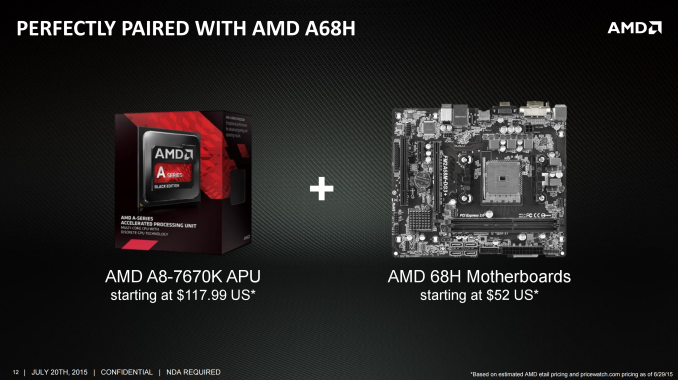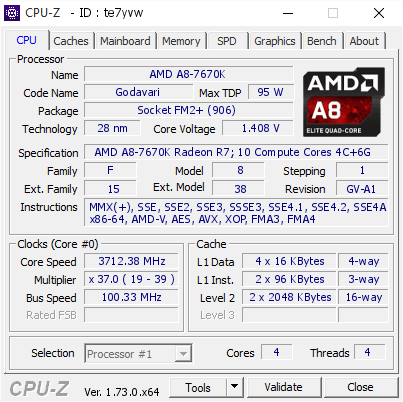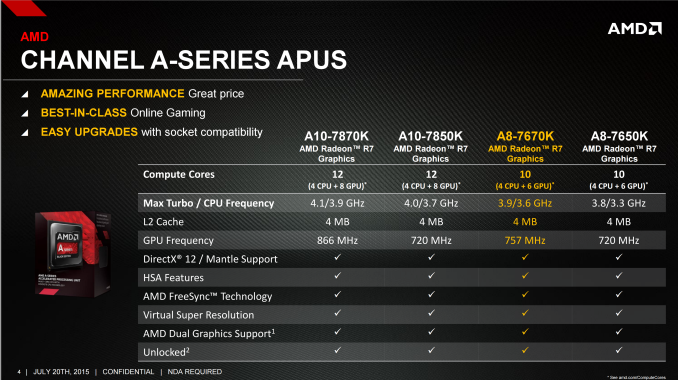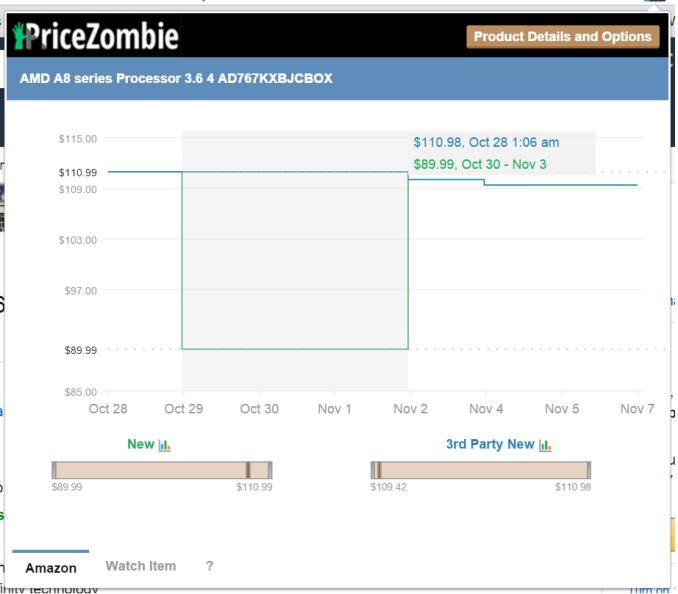The AMD A8-7670K APU Review: Aiming for Rocket League
by Ian Cutress on November 18, 2015 8:00 AM EST
Over the past couple of years, AMD has slowly released their mainstream brand of Kaveri processors. In turn, we have reviewed them, and they consistently aim to provide a midrange integrated gaming option, especially for those on a budget. The recent release of the A8-7670K was perhaps not that exciting, as AMD is filling up their product stack with new parts, taking advantage of an improved manufacturing process and aggressive binning. To that end, we're taking a different tack with this review. Alongside the regular tests, we also corralled Rocket League (an amazingly simple yet popular take on car football/soccer that sits on the precipice of e-sports glory) into a benchmark aimed at those sub-$600 gaming systems.
The AMD A8-7670K
Earlier this year, AMD announced their new line of Kaveri Refresh processors, starting with the A10-7870K (which we reviewed here). As the name suggests, these are Kaveri processors at their core, still based on the combination of Steamroller processor cores and 2nd generation Graphics Core Next (GCN) microarchitecture for graphics. These new refresh models are designed to take advantage of minor improvements in manufacturing, resulting in the ability to get higher clock speed for the same power consumption, even 18 months after the first Kaveri processors hit the scene. As a result, these Refresh processors — or, to use AMD's internal code name, "Godavari" — fill in the blank spots in the product stack and supersede the older parts, with the aim of squeezing in more frequency and performance for the same power consumption. It sounds deceptively simple — improve your process, refresh the part at the same price, and reap the benefits.
If we look at AMD's current lineup, we see that this new A8-7670K surpasses the older A10-7700K on the specification sheet, and comes in cheaper when brand-new.
| AMD Kaveri Lineup | ||||||||
| A10- 7870K |
A10- 7850K |
A10- 7800 |
A10- 7700K |
A8- 7670K |
A8- 7650K |
A8- 7600 |
X4 860K |
|
| Price | $137 | $134 | $131 | $120 | $118 | $104 | $89 | $85 |
| Modules | 2 | 2 | 2 | 2 | 2 | 2 | 2 | 2 |
| Threads | 4 | 4 | 4 | 4 | 4 | 4 | 4 | 4 |
| Core Freq. (GHz) | 3.9-4.1 | 3.7-4.0 | 3.5-3.9 | 3.4-3.8 | 3.6-3.9 | 3.3-3.8 | 3.1-3.8 | 3.7-4.0 |
| Compute Units | 4+8 | 4+8 | 4+8 | 4+6 | 4+6 | 4+6 | 4+6 | 4+0 |
| Streaming Processors |
512 | 512 | 512 | 384 | 384 | 384 | 384 | N/A |
| IGP Freq. (MHz) | 866 | 720 | 720 | 720 | 754 | 720 | 720 | N/A |
| TDP | 95W | 95W | 65W | 95W | 95W | 95W | 65W | 95W |
| DRAM Frequency |
2133 | 2133 | 2133 | 2133 | 2133 | 2133 | 2133 | 1866 |
| L2 Cache | 2x2MB | 2x2MB | 2x2MB | 2x2MB | 2x2MB | 2x2MB | 2x2MB | 2x2MB |
As it stands, the A8-7670K is a dual-module 3.6 GHz base frequency processor with a boost frequency up to 3.9 GHz. It comes with six graphics compute units, which translates to 384 streaming processors, similar to other A8 parts, but at a slightly higher IGP frequency of 754 MHz. The combined increase in processor and integrated graphics frequencies come at no extra cost in thermal design, with the A8-7670K at the same 95W TDP.
One of AMD's marketing strategies with these ~$100 processors is the price/performance angle. Aside from the integrated graphics, each of the AMD processors can pair with an R7 240 or R7 250 graphics card (DDR3 or GDDR5; AMD suggests an R7 250 GDDR5, as you might expect) in a hybrid dual graphics scenario, boosting performance. Thus, for the same price as an APU and an R7 250 graphics card, on average, AMD aims to offer a better gaming experience — especially for games that run at around 60 frames per second on medium settings — than a similarly priced Intel + NVIDIA platform. We've seen this marketing spiel corroborated in previous reviews, and would expect not to see anything different here. At launch, AMD put a $118 price on the A8-7670K, which, in recent sales, has been pushed down to under $100 at times.
The A8-7670K is an FM2+ socket processor, and thus requires either an A88X, A85X, A78 or A68 motherboard to go with it in order to take full advantage. As part of the launch, and given that this processor is a slightly boosted A8-7650K, AMD sees value in pairing it with something like a $50 A68H motherboard, making an APU+MB combination around $150 when on sale. However, as one might imagine, due to the age of the FM2/FM2+ socket, there are relatively few "new" motherboards on the market. The last one we reviewed was MSI's A88X-G45 Gaming, which brought over some of the components seen on its new Intel gaming motherboards, but other manufacturers have also put out M.2 capable AMD chipset-based motherboards as well.













154 Comments
View All Comments
milli - Thursday, November 19, 2015 - link
Sounds good :)BrokenCrayons - Thursday, November 19, 2015 - link
95 watts is too much for a modern CPU to require.plonk420 - Thursday, November 19, 2015 - link
that's watts TDP, not watts at the wall.BrokenCrayons - Friday, November 20, 2015 - link
Yes, that's fine. It's too high for a modern CPU. Half that would be more reasonable and a tenth would be better still, but not at all perfect.TheinsanegamerN - Friday, November 20, 2015 - link
The i3 is still a 47 watt chip. the skylake i7s are 95 watt. It seems most "modern" cpus are in the 65-95 watt range, with 47 watt for dual cores.A tenth of 95 watt is only 9.5, which is core m territory. it works, but it ISNT for power users. So i'm not sure what 'modern' cpu you are referring to, as it doesn't seem to exist. And AMD's APUs can be set to 65 or 45 watt mode as well, but you get a performance hit. So half the TDP already exists, and a tenth is too little for a big CPU.
BrokenCrayons - Friday, November 20, 2015 - link
Yes, the i3 is an Intel processor. Skylake's 95 watt chip is an outlier that's highly uncommon. The vast majority of computers purchased are inexpensive laptops which regularly only rise to 35 watts. Desktop processors are not only a rarity, but those that range above 65 watts are very uncommon and largely the domain of expensive workstations and the very small number of gaming systems out there. It's pretty odd of AMD to sell a budget processor that puts those kinds of demands on a system and, in my opinion, unreasonable given the competition in the same approximate performance.silverblue - Friday, November 20, 2015 - link
I know it's hardly comparable, but I wonder what power an i3 with Godavari-level GPU would use if at 28nm. Besides, TDP != actual power usage.TheinsanegamerN - Friday, November 20, 2015 - link
Desktops are rare now? Ok. You must not work in business. Desktops Are still common, not as much as laptops, but the forecast for all of 2015 was north of 120 million desktops, the vast majority of which are business machines with i5 processors, which are 65-84 watt. I7s are rated at 84 watt for haswell, 77 for ivy bridge, and 95 for sandy bridge, and 95 for skylake, so it's much more common than you think.As for laptops, I'm not sure why you brought them up, seeing as the a8 is a DESKTOP chip. on DESKTOPs, CPUs with 65 watt TDPs are very common. Any i5, i7, pretty much any APU from AMD, are all 65 watt+. Laptops typically use dual core chips with much lower clock rates and power restricted GPUs. The vast majority of laptops, with those 35 watt chips (and most of the skylake and broadwell chips in laptops are 15 watt BTW, 35 watt isn't really used much anymore) can't compare to a 95 watt desktop chip in performance, so it still won't work for power users.
So when you say that the TDP is too high for a modern processor, you mean it's too much for a mobile processor, ignoring that this is a processor for desktops. Unless you want a desktop processor with a mobile TDP but desktop performance, which will never happen, because a higher TDP chip will be clocked higher. Always.
Deshi - Friday, November 20, 2015 - link
Does that 95 watts include the onboard GPU? if thats the case, thats not so bad, since you would need to addin the added dGPU TDP if you build an intel + nvidia/radeon to match the performance.nos024 - Thursday, November 19, 2015 - link
blah...after 4 years and Intel's IGP is still on the heels of AMD's APU. Bleh.Give me graphics performance comparable to a 750ti and an ITX motherboard with M.2 storage option and I'll will go and buy it this very instance. I want something like that.
Low profile ITX-case + 8gb RA
M + 240/256GB M.2 RAM (SATA or PCIe) + 300W PSU + ITX MB with AC wireless + APU with 750ti GPU performance. Is that so hard to ask for?! Apparantly so.